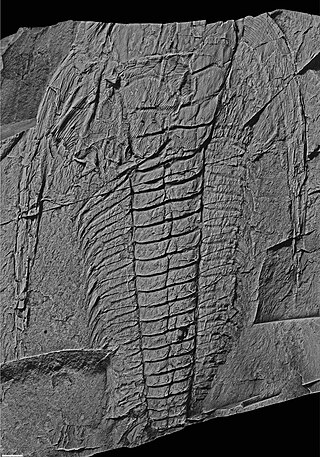
John William Salter was an English naturalist, geologist, and palaeontologist.

Paradoxides is a genus of large to very large trilobite found throughout the world during the Middle Cambrian period. One record-breaking specimen of Paradoxides davidis, described by John William Salter in 1863, is 37 cm (15 in). The cephalon was semicircular with free cheeks ending in long, narrow, recurved spines. Eyes were crescent shaped providing an almost 360° view, but only in the horizontal plane. Its elongate thorax was composed of 19-21 segments and adorned with longish, recurved pleural spines. Its pygidium was comparatively small. Paradoxides is a characteristic Middle-Cambrian trilobite of the 'Atlantic' (Avalonian) fauna. Avalonian rocks were deposited near a small continent called Avalonia in the Paleozoic Iapetus Ocean. Avalonian beds are now in a narrow strip along the East Coast of North America, and in Europe.
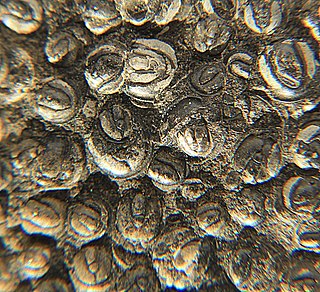
Agnostus is a genus of agnostid trilobites, belonging to the family Agnostidae, that lived during the late Middle Cambrian – early Upper Cambrian. It is the type genus of the family Agnostidae and is subdivided into two subgenera, Agnostus and Homagnostus.
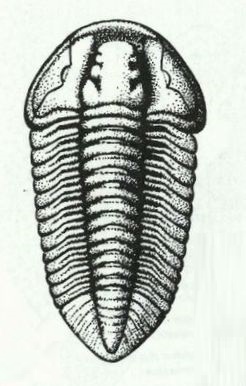
Flexicalymene Shirley, 1936. is a genus of trilobites belonging to the order Phacopida, suborder Calymenina and Family Calymenidae. Flexicalymene specimens can be mistaken for Calymene, Gravicalymene, Diacalymene and a few other Calymenina genera. They are used as an index fossil in the Ordovician. Ohio and North America are particularly known for being rich with Flexicalymene fossils.

Agraulos Hawle & Corda 1847, is a genus of trilobites that lived during the Middle Cambrian in North America and Europe, particularly the Czech Republic.

Acontheus is a genus of trilobites belonging to the Family Corynexochidae, Order Corynexochida, and is geographically widespread having been recorded from middle Cambrian strata in Sweden, Newfoundland, Germany, Siberia, Antarctica, Queensland, China and Wales.
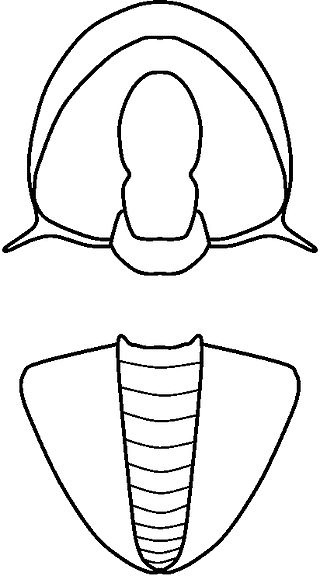
Acidiscus Rasetti, 1966, is a genus of Eodiscinid trilobite belonging to the family Weymouthiidae Kobayashi T. (1943), Order Agnostida Salter (1864). It lived during the Botomian stage = late Lower Cambrian Stage 4 ; the upper Botomian boundary corresponds to base of the Middle Cambrian, Miaolingian Series and Wuliuan stage.
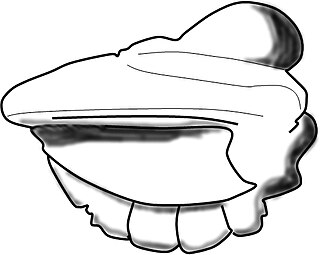
Chelediscus Rushton, 1966, is a genus of Eodiscinid trilobite belonging to the family Weymouthiidae Kobayashi T. (1943), Order Agnostida Salter (1864). The Treatise assigns this genus to the Calodiscidae; Cotton and Fortey (2005) however move it to the Weymouthiidae. Chelediscus lived during the later part of the Botomian stage.

Peronopsis is a genus of trilobite restricted to the Middle Cambrian. Its remains have been found in Asia, Australia, Europe, and North America.

Caerfai Bay is a rocky cove on the north coast of St Brides Bay near St Davids in Pembrokeshire, West Wales. It is enclosed by steep varicoloured cliffs and has a sandy beach at low tide accessed by pathway and steps. The beach is situated in the Pembrokeshire Coast National Park and on the Pembrokeshire Coast Path. There is free parking above the beach with picnic benches and views of the islands of Penpleidiau, Skomer and Skokholm.

Pagetia Walcott, 1916. is a small genus of trilobite, assigned to the Eodiscinid family Pagetiidae and which had global distribution during the Middle Cambrian. The genus contains 55 currently recognized species, each with limited spatial and temporal ranges.

Ptychagnostus is a member of the agnostida that lived during the Cambrian period. Ptychagnostidae generally do not exceed one centimetre in length. Their remains are rarely found in empty tubes of the polychaete worm Selkirkia. The genus probably ranged throughout the water column. It has two glabellar lobes, and three pygidial lobes.
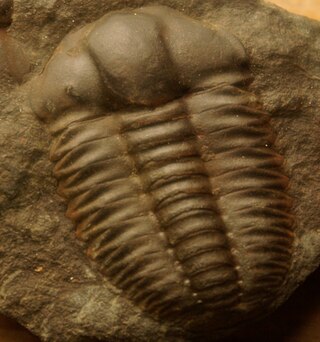
Ellipsocephalus Zenker, 1833, is a genus of blind Cambrian trilobite, comprising benthic species inhabiting deep, poorly lit or aphotic habitats. E. hoffi is a common trilobite mainly from central Europe.

Phalagnostus is a genus of small trilobites, in the order Agnostida. It lived during the Middle Cambrian, in what are now Canada, China, the Czech Republic, Denmark, England, France, the Russian Federation, Wales, Sweden, and possibly the United States (Vermont). The headshield is almost entirely effaced and wider than the tailshield. The pygidium is also very effaced, but the ovate pygidial axis is well defined and a border furrow is also present.
Diplorrhina Hawle and Corda (1847) is a genus of trilobite belonging to Order Agnostida. It lived during the early Middle Cambrian in what are now the Czech Republic and the North Siberian plateau. as in members of the family Peronopsidae it lacks a preglabellar furrow. Both cephalon and pygidium lack spines. It is difficult to distinguish Diplorrhina from many other peronopsids.
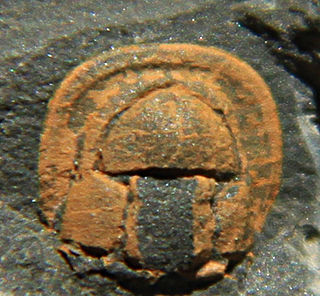
Condylopyge Hawle and Corda (1847) is a genus of agnostid trilobite that lived during the late Lower and early Middle Cambrian, in what are today Canada, the Czech Republic, England and Wales, France, Germany, Italy, Morocco, the Russian Federation, Spain, Turkey and Sweden. It can easily be distinguished from all other Agnostida because the frontal glabellar lobe is notably wider than the rear lobe. It belongs to the same family as Pleuroctenium but the frontal glabellar lobe does not fold around the rear lobe, as it does in that genus. Condylopyge is long ranging, possibly spanning the early Cambrian Terreneuvian Series in Nuneaton, central England into at least Drumian strata at various locations elsewhere.
The Hells Mouth Grits, formally defined and renamed the Hells Mouth Formation by Young et al., is a geological formation composed of Cambrian Greywackes in the south west part of St. Tudwal's Peninsula. Equivalent to the Rhinog Formation in the Harlech Dome, the grit beds exposed at St Tudwal's are very uniform in lithology and thickness when traced along the outcrops, with a gradual thinning southwards. They exhibit the characteristic textures and structures of greywackes but differ from the normal type in being relatively well sorted and commonly laminated. Intercalated mudstones are more variable both in thickness and in lithology and contain laminated mudstones rich in sponge remains. The sandstones have sharply defined bases, often bearing sole structures and occasionally loaded. Sandstone dykes cut down from the bases of some beds and extend through up to 0.6 m of underlying siltstones. The sandstones may form sheets up to 4 m thick, although a bed thickness of up to 1m is more usual, and have been interpreted as turbidites deposited by currents from the northeast.

Plutonides is a genus of Middle Cambrian trilobite in the family Paradoxididae with species Plutonides sedgwickii and possibly Plutonides? illingi. Several other species and subspecies were at times placed in Plutonides but have subsequently been moved to other genera.

Serrodiscus Richter and Richter 1941. is a genus of Eodiscinid trilobite belonging to the family Weymouthiidae Kobayashi T. (1943), Order Agnostida. It lived during the late Lower Cambrian, with remains found in Canada, China (Gansu), The United Kingdom (England), Germany (Silesia), Poland, the Russian Federation, and the United States. It is named for the spines on the ventral side of the pygidium, which give it a serrated impression.

Bailiaspis Resser, 1936, is a Middle Cambrian (Miaolingian) trilobite genus belonging to the Family Conocoryphidae Angelin, 1854. Within the Acado-Baltic region, the genus ranges from Wuliuan into Guzhangian age strata.



















